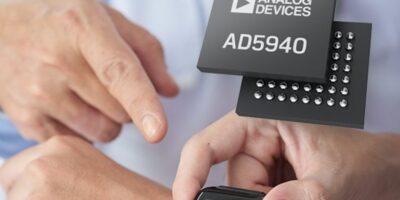Analog Devices integrates electrochemical and impedance measurement
The AD5940 is an electrochemical and impedance measurement front end released by Analog Devices that enables the next generation of vital sign monitoring devices and intelligent electrochemical sensors. The AD5940 incorporates both potentiostat and electrochemical impedance spectroscopy (EIS) functionality on a single chip, allowing for sensor measurement in both time and frequency domains.
The AD5940 has integrated hardware accelerators for sensor diagnostics and is claimed to have best-in-class low noise for accurate sensor measurements.
Analog Devices says that other options currently available from competitors require multiple ICs to achieve similar performance. The single chip is claimed to offer advantages in terms of system accuracy and size flexibility to measure two-lead, three-lead and four-lead electrochemical sensors. The AD5940 can be used wherever high precision biological and chemical sensing is mission-critical, such as industrial gas sensing, liquid analysis, material sensing, vital signs monitoring, impedance spectroscopy and disease management.
The AD5940 is claimed to be the lowest power, highest performance Impedance and electrochemical front end with intelligent autonomous control. The on-chip potentiostat allows for a host of standard electrochemical-based measurement techniques, such as amperometric, voltametric, or impedance measurements.
It is designed to be used in healthcare-related bio-impedance systems for both skin impedance and body impedance measurements, and also to work with Analog Devices’ AD8233 AFE in a complete bioelectric/biopotential measurement system.
The analogue front end chip can measure voltage, current and impedance. There are two potentiostat loop and a low bandwidth loop with the ability to generate AC signals up to 200 Hz while a high bandwidth loop can generate AC signals up to 200kHz. The low power potentiostat consumes 6.5 microA in biased mode.
The AD5940 measurement channel features a 16-bit, 800ksamples per second, multi-channel successive approximation register (SAR) analogue to digital converter (ADC) with input buffers, a built in anti-alias filter (AAF), and a programmable gain amplifier (PGA).
The ADC features an input voltage range of ±1.35V. An input mux before the ADC allows the user to select an input channel for measurement. These input channels include multiple external current and voltage inputs, and internal voltage channels. The internal channels enable on chip diagnostic measurements of the internal supply voltages, die temperature, and reference voltages.
The AD5940 measurement blocks can be controlled via direct register writes through the serial peripheral interface (SPI) or, by using a pre-programmable sequencer, which provides autonomous control of the AFE chip. There is 6kbyte of static random access memory (SRAM) partitioned for a deep data first in, first out (FIFO) and command memory. Measurement commands are stored in the command memory and measurement results are stored in the data FIFO. A number of FIFO related interrupts are available to indicate state of the FIFO.




